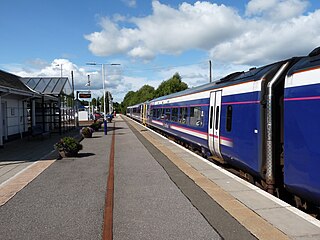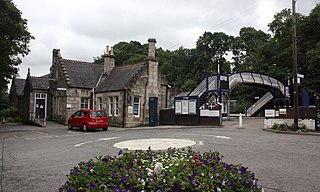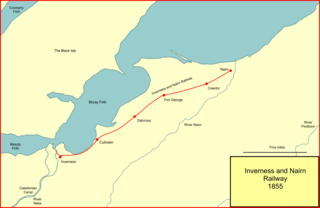
The Highland Railway (HR) was one of the smaller British railways before the Railways Act 1921, operating north of Perth railway station in Scotland and serving the farthest north of Britain. Based in Inverness, the company was formed by merger in 1865, absorbing over 249 miles (401 km) of line. It continued to expand, reaching Wick and Thurso in the north and Kyle of Lochalsh in the west, eventually serving the counties of Caithness, Sutherland, Ross & Cromarty, Inverness, Perth, Nairn, Moray and Banff. Southward it connected with the Caledonian Railway at Stanley Junction, north of Perth, and eastward with the Great North of Scotland Railway at Boat of Garten, Elgin, Keith and Portessie.

The Highland Main Line is a railway line in Scotland. It is 118 mi (190 km) long and runs through the central Scottish Highlands, mainly following the route of the A9, and linking a series of small towns and villages with Perth at one end and Inverness at the other. Today, services between Inverness and Edinburgh, Glasgow and London use the line. At Inverness the line connects with the Far North Line, the Aberdeen-Inverness Line and the Kyle of Lochalsh Line. Since the line is not electrified all trains are diesel-powered.

Perth railway station is a railway station located in the city of Perth, Scotland, on both the Glasgow to Dundee line and the Highland Main Line. It is managed by ScotRail, who provide almost all of the services.

Dingwall railway station serves Dingwall, Scotland. It is located just south of the junction of the Far North Line and the Kyle of Lochalsh Line, and is managed and served by ScotRail. The station is 18 miles 58 chains (30.1 km) from Inverness, and is the zero point for the Kyle of Lochalsh Line. It is sited after Conon Bridge heading northbound, with the next station being either Garve or Alness.

Aviemore railway station serves the town and tourist resort of Aviemore in the Highlands of Scotland. The station, which is owned by Network Rail (NR) and managed by ScotRail, is on the Highland Main Line, 83 miles 31 chains from Perth, between Kingussie and Carrbridge, and is also the southern terminus of the Strathspey preserved railway.

Inverness railway station serves the Scottish city of Inverness. It is the terminus of the Highland Main Line, the Aberdeen–Inverness line, the Kyle of Lochalsh line and the Far North Line.

The Aberdeen–Inverness line is a railway line in Scotland linking Aberdeen and Inverness. It is not electrified. Most of the line is single-track, other than passing places and longer double-track sections between Insch and Kennethmont and Inverurie and Berryden Junction (Aberdeen).

Ardgay railway station is a railway station serving the village of Ardgay and its neighbour Bonar Bridge in the Highland council area of Scotland. The station is on the Far North Line, 57 miles 70 chains (93.1 km) from Inverness, between Tain and Culrain. ScotRail, who manage the station, operate all services.

Forres railway station serves the town of Forres, Moray in Scotland. The station is managed and served by ScotRail and is on the Aberdeen–Inverness line, between Nairn and Elgin, measured 119 miles 42 chains (192.4 km) from Perth via the Dava route.

Elgin railway station is a railway station serving the town of Elgin, Moray in Scotland. The station is managed and served by ScotRail and is on the Aberdeen to Inverness Line, between Keith and Forres, measured 12 miles 18 chains (19.7 km) from Forres.

Keith railway station is a railway station serving the town of Keith, Moray, Scotland. The station is managed by ScotRail and is on the Aberdeen to Inverness Line, between Huntly and Elgin, measured 53 miles 8 chains (85.5 km) from Aberdeen, or 30 miles 20 chains (48.7 km) from Forres.

Insch railway station is a railway station serving the village of Insch, Aberdeenshire, Scotland. The station is managed by ScotRail and is on the Aberdeen to Inverness Line, between Inverurie and Huntly, 27 miles 47 chains (44.4 km) from Aberdeen.

Dunkeld & Birnam railway station serves the town of Dunkeld and village of Birnam in Perth and Kinross, Scotland. It is located on the Highland Main Line, 15 miles 31 chains (24.8 km) north of Perth and is the first stop on the line north of there, before Pitlochry. Most services are operated by ScotRail, who also manage the station. LNER and Caledonian Sleeper also call some services here.

Pitlochry railway station is a railway station serving the town of Pitlochry in Perth and Kinross, Scotland. It is managed by ScotRail and is located on the Highland main line, 28 miles 21 chains (45.5 km) from Perth, between Dunkeld & Birnham and Blair Atholl.

Carrbridge railway station serves the village of Carrbridge, Highland, Scotland. The railway station is managed by ScotRail and is on the Highland Main Line, 90 miles from Perth, between Aviemore and Inverness.

Newtonmore railway station serves the village of Newtonmore, Highland, Scotland. The station is managed by ScotRail and is on the Highland Main Line. The station is 68 miles 62 chains (110.7 km) from Perth, between Dalwhinnie and Kingussie, and has a single platform which is long enough for a ten-coach train. It is currently the only station on the Highland Main Line to have one platform, although the former second platform can still be seen adjacent to the first platform.

The Inverness and Nairn Railway was a railway company that operated between the burghs in the company name. It opened its line in 1855 and its passenger business was instantly successful. At first it was not connected to any other line. However it was seen as a first step towards connecting Inverness and Central Scotland, via Aberdeen and when feasible, directly southwards.
The Inverness and Aviemore Direct Railway was a section of railway built by the Highland Railway to provide a shorter and more direct route between Inverness and Aviemore, carrying its main line traffic to Perth and the south.

The Inverness and Perth Junction Railway (I&PJR) was a railway company that built a line providing a more direct route between Inverness and the south for passengers and goods. Up to the time of its opening, the only route was a circuitous way through Aberdeen. The I&PJR was built from a junction with the friendly Inverness and Aberdeen Junction Railway at Forres to the Perth and Dunkeld Railway at Dunkeld.
The Inverness and Aberdeen Junction Railway (I&AJR) was a railway company in Scotland, created to connect other railways and complete the route between Inverness and Aberdeen. The Inverness and Nairn Railway had opened to the public on 7 November 1855 and the Great North of Scotland Railway (GNoSR) was building from Aberdeen to Keith. The I&AJR opened, closing the gap, on 18 August 1856.



















